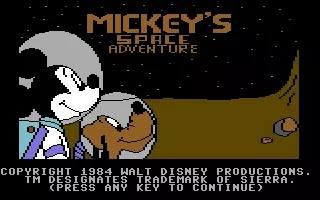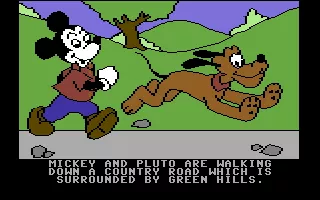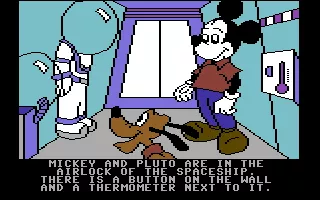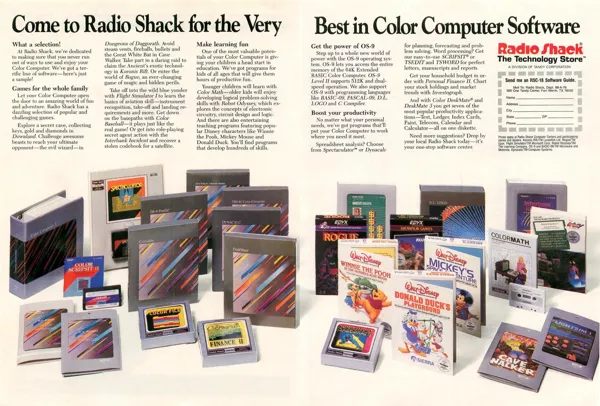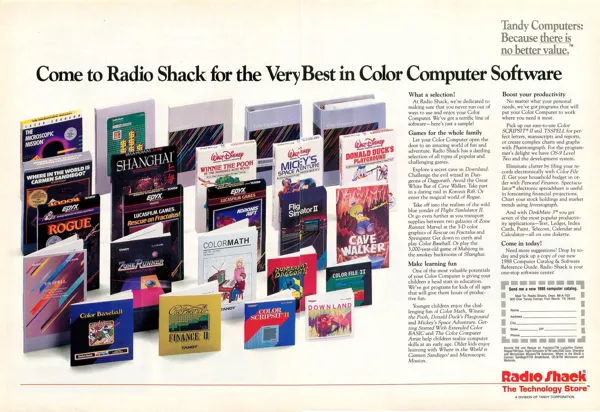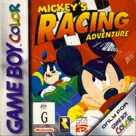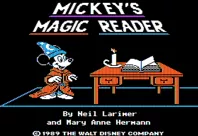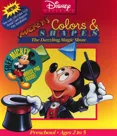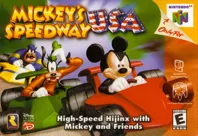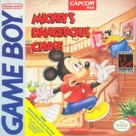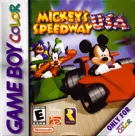Mickey's Space Adventure
Description
Walking along one day, Mickey and Pluto come across a spaceship. After boarding the ship, they are given a quest by XL30 from the planet Oron. A long time ago, a thief stole the planets memory crystal and broke it up into nine pieces, hiding them on each planet in the solar system. It is Mickey's job to travel to each planet and locate the crystals so the inhabitants of the planet Oron may receive their memory back. Information about the different planets and locations visited are displayed on arrival, and XL30 may occasionally give clues through the ships computer. The interface for the game doesn't use a text parser, instead short sentences are created by using the cursor keys to highlight the necessary words from a selection on the screen. The game will also suggest better options if an illogical or impossible action is requested.
Groups +
Screenshots
Promos
Credits (Commodore 64 version)
10 People
| Designed by |
|
| Commodore Programs by | |
| Utilities and Graphics Routines | |
| Graphics by | |
| Music by | |
| Player's Guide by | |
| Illustrations by |
Reviews
Critics
Players
Average score: 4.1 out of 5 (based on 13 ratings with 3 reviews)
The Disney-licensed game that teaches children about space
The Good
Like Donald Duck's Playground and Winnie the Pooh in the Hundred Acre Wood before it, Sierra once again teamed up with Disney to create another children's game. Mickey's Space Adventure. Of course, the main character is Mickey who teams up with Pluto in search of the seven crystals that were stolen from Oron by an inter-planetary space thief, and its segments scattered around the solar system. Without it, the citizens of Oron have no idea about their history. And not only will Mickey have to put the crystals back together again, but they must be put together in the correct order.
Unlike Troll's Tale and Winnie where you have to select the path that you will take in order to proceed further, Space Adventure is a similar to Sierra's future adventure games, except that there is no typing parser involved. Instead, you have to select a verb-noun combination from a list of options that you are given, and to make things happen like they should, select an appropriate combination of words. If you happen to select a "nonsense" combination like EAT NORTH, all the game says to you is "Huh?".
The traveling from planet to planet is all done inside your spaceship, but the planet that you need to go to next isn't quite so obvious, unless you have some knowledge about space. If you have none, then you either read some text books and look for the answer there, or find the answer in the game's manual, but seeing as I don't have the manual with me, I can't confirm this. On most planets, the crystal segments that you need to get are out in the open. Some planets, on the other hand, require you to do a little digging. Before you go ahead and set foot on a planet, you need to wear your spacesuit due to the hazardous conditions on each planet. When you are out exploring, you better hurry up and find those crystals, otherwise your air supply will get low, as you can expect in real life. You also need to change disks every time you attempt to leave the spaceship. If you decide that you need a rest and want to resume the game at a later date, you can save the game, but you can only do this in your spaceship.
Consider Space Adventure to be an educational game, rather than an adventure. On most screens, the game tells you what the picture is about, whereas on others, you are presented with some brief information on the planet, though it can't be compared with Where in Space is Carmen Sandiego? Deluxe Edition, with its planet summary sheet and rather detailed information database that covers everything.
The game can be played in either CGA or EGA, but the game will not be as detailed in CGA as you have to suffer having a 4-color palette. With EGA, the game is colorful and everything is colored in exactly like Disney's old cartoon show. (Most Disney's characters like Mickey, Goofy, Pluto, Donald, and others have now fazed out.) The sound comes through the PC Speaker, which might not be a problem for you if you did have a PC back in 1986. The beeps that it produces are not bad for a kid's game.
The Bad
The only gripe that I had with this game is the way that you have to press a button twice after highlighting the "noun' in among the list of commands, rather than once.
The Bottom Line
In conclusion, Space Adventure is still an adventure game, where it teaches you about each planet in the solar system, and the game will take about an hour to complete. Even if you complete Space Adventure the first time, you are encourage to discover the alternate ending. Can you die in this game? I'll leave that up to you to explore each planet thoroughly and see if you can.
DOS · by Katakis | カタキス (43091) · 2005
Sierra's colorful adventure game that teaches children astronomy as they play
The Good
Not many games in the early Eighties teached children about astronomy, but there was one game Sierra released that did exactly that. Mickey's Space Adventure was designed by Roberta Williams, who previously worked on Mystery House and the first King's Quest game. It was published by Walt Disney Computer Software, who has put their famous characters into the game.
The player controls Mickey who has been tasked with finding the nine crystals scattered on nine planets in Earth's solar system. These crystals are important to the inhabitants of the planet Oron as they contain their memories. XL30, the planet's computer, beams a spaceship down near Mickey's home on Earth so that he can reach the planets.
Flying to different planets requires a knowledge of astronomy as well as the ability to read. XL30 outlines where players need to go to, but doesn't reveal the name of the planet. It just gives you clues and you have to use those clues to push some buttons in the right order.
Joining him is his pet dog Pluto who mainly follows Mickey around like a puppy dog he is, but he can also be helpful to Mickey as he is capable of digging out any crystals that are stuck in the planet's soil.
There are plenty of scenes to explore in the game. The game gives a brief description of each scene, along with commands split into two lines, with the first line containing the verb and the other line containing the nouns. To get through the game, players must enter a verb-noun combination. What I like about this is that you can execute many nonsense commands just for the fun of it, to have the game produce a "you can't do that" message.
Mickey's Space Adventure has the most colorful graphics I have ever seen in a Disney game. Both Pluto and Mickey are drawn the way they should, and some of the planets that you walk around in look very good. I enjoyed looking at the scene where you look out onto the planet's moon, and exploring the icy castle on Neptune.
There are some amusing scenes in the game, mainly involving something that guards one of the crystals you need to get. On Pluto, for example, the crystal is guarded by three Pluto dogs; and you have to give an alien your sunglasses, and he puts them on.
The only way you can lose the game is if you are on a planet and are running out of oxygen. XL30 gives players a series of warnings after you execute a number of commands, meaning that you need to return to the spaceship. Other than this, I can't recall any parts where you could die. On one of the planets, I was captured by the guards while in the temple and I thought they were going to kill me. False alarm.
There is some nice music brilliantly done by Al Lowe, who also wrote the music for King's Quest II. It is composed in such a way that they reflect the same type used in the old Disney cartoons. Another piece of nice music is featured when you get a crystal. There are some sound effects in the game, and I always liked the way that they play while you are figuring out what your next command is.
The box claims that the game is different every time a game is played. I think that what they meant is the order in which you navigate between planets will be different each time. I also believe that this is the first game to feature an alternate ending.
The Bad
When you push the wrong button on the control panel by accident, you can't undo your action. You can only make up a combination of six buttons or one that the game doesn't recognize as a code to get to a planet.
Mickey's Space Adventure is shipped with five disks with the fifth one being a save disk. The game only supports one drive, so there is a fair amount of disk swapping in the game. Mickey entering the spaceship and getting out to explore a planet requiring players to change disks. If you have the wrong disk inserted, the game doesn't even tell you what disks it needs and you have to guess which disk to insert.
The Bottom Line
Mickey's Space Adventure is an educational adventure game that teaches children about astronomy, and has them exploring planets and searching for crystals they need to finish the game. It features the Disney characters Mickey and Pluto so children who are interested in Disney will enjoy playing the game. The graphics are colorful, and there is nice sound. Even though the game is designed for children, adults can find it entertaining as well.
Commodore 64 · by Katakis | カタキス (43091) · 2012
Nice attempt but I don't think it hits a spot
The Good
In this Disney licensed game, Mickey and Pluto are travelling around Solar System and searching for nine crystals. Each at one planet (in case of gas giants, it's on nearby moon). I am big fan of astronomy (I made astronomy themed game as well), so despite of childish game setup I gave it a try and finished the game (around 3 hours). Now to good points:
-
astronomy education - I really appreciate that. On every planet, there's basic educational text and facts about it, so that's really nice.
-
graphics - for 1985 title it has nice full screen and true Disney graphics. Running 16-color Tandy version was a pain (only DOSBox-x which allows to setup machine to 128kB RAM in Advanced settings, then machine type Tandy). But because screens are static, I didn't mind also CGA composite mode.
-
it's Mickey and Pluto - and there's surprise on Pluto (which was still a planet back then btw) :)
And in the end, technical execution was well (as it was with most of Sierra titles in those times already).
The Bad
The game is a bit repetitive. On every planet, there are several screens where majority is just deco, with no gameplay elements, and only few screens are important. Also you can run out of oxygen, so you have to return to spaceship and then go back to planet surface again. Rinse and repeat every time.
Also, I'm not sure about game's target group. It's really easy for adults, in the end, it's Disney game. But can be quite hard for children of age which are excited about Mickey Mouse. By its difficulty, it's for children about 10 years I guess.
The Bottom Line
Cute attempt for educational adventure game. Technically well executed. It's just gameplay / difficulty which for me is somehow not very well defined. For 5-7 years old (which can be excited about Mickey), it's a bit too hard, for 10 years old (which can beat it), it can be already quite uninteresting.
DOS · by Vladimir Dienes · 2023
Trivia
Graphics
The PC versions of Sierra's games often supported 16 colors on CGA with a composite monitor or EGA and Tandy with an RGB monitor. Although the 16 colors available on CGA composite displays are not the same as those available with EGA and Tandy, they are close enough so the RGB colors can be mapped to a reasonably similar composite color. However almost all of Sierra's games reverse red and purple on composite displays for some reason (what's red in RGB displays as purple on composite, and purple in RGB displays red on composite). Mickey's Space Adventure is unique in that this reversal turns out to be an advantage for the composite mode; Mickey's shirt and the planet Mars display correctly as red in CGA composite mode but purple in Tandy mode.
Analytics
Upgrade to MobyPro to view research rankings!
Identifiers +
Contribute
Are you familiar with this game? Help document and preserve this entry in video game history! If your contribution is approved, you will earn points and be credited as a contributor.
Contributors to this Entry
Game added by Servo.
TRS-80 CoCo added by L. Curtis Boyle. Apple II added by Garcia.
Additional contributors: Alaka.
Game added September 26, 2002. Last modified November 17, 2023.

